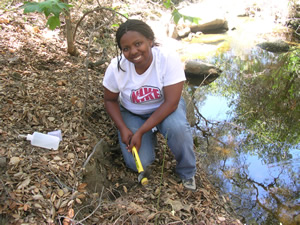Drying Out
Student Researcher Finds That Drying Out Soil Can Drive Out Ant Hordes
November 11, 2008
By Russ L. Hudson

Kimberly Nelson at work at the Audubon Society's Starr Ranch Sanctuary. Digging into an ant colony to study its structure is part of the research.
They invade homes, classrooms, offices, garages — almost everywhere in Southern California. Argentine ants are the aggressive and persistent little black ants that in dry spells march in long chains from a tiny hole or crack in a wall or from under a floorboard.
But senior biological science major Kimberly Nelson may have the weapon to defeat them: water. Or, more precisely, a lack of water.
In her research in Starr Ranch Sanctuary in Trabuco Canyon, Nelson has shown that by depriving Argentine ants of water, they can be defeated with little or no use of poisons or other dangerous and polluting substances.
“Once an area has been dried of excess water, Argentine ants will start moving out,” Nelson said. “It could take anywhere from one to six months, depending on the time of year. As soon as the area is dry of sufficient water sources, they’ll retreat to someone’s wetter yard or other moist place and establish there.
“Native ants can survive on natural dew fall,” she said. “Argentine ants need three times or more water than native ants and they need it continuously. If it dries up where they are, they look for it — often indoors.“
Studies show that Argentine ants dominate nearly every area in Southern California with moist soil.
Many homeowners believe ants invade homes in search of food, but they seek water, said Nelson, adding that finding food is serendipitous. Because Argentine ants proliferate rapidly and have few natural predators, they overwhelm native species.
The presence of Argentine ants — Iridomyrmex humilis — in the U.S. dates to the 1890s, studies show, when ships from Argentina and Brazil unloaded coffee in New Orleans. They quickly spread across the southern part of the country, thriving especially in coastal areas. They now dominate the ant population of California.
Nelson recognized the opportunity to study the Argentine ant invasion at the 4,000-acre Audubon Society-owned and operated Starr Ranch. She spotted her chance while studying ecosystems with Paul Stapp and Bill Hoese, associate professors of biological science, during the summer Southern California Ecosystems Research Program, a National Science Foundation-sponsored effort in which undergraduates with interests in the environment and ecosystems can take part.
“I heard about the riparian habitat restoration project by the Audubon Society for the areas between an 1,100-home and golf course development and the Tick and Dove creeks that run through Starr. The development let its runoff flow into the creeks,” said Nelson.
“Under Sandy DeSimone, director of research and education at Starr, pumps were being installed to pump the runoff back into the housing development for recycling. That would restore the natural water content of the area.”
Wherever runoff moistened normally dry soil, Argentine ants took over — lots of them, Nelson said. “I had a chance to monitor the effects of the drying soil.”
Keeping the soil dry, however, drove the ants away, Nelson said, which argues for using native plants that need little or no irrigation for landscaping. It also points out the importance of fixing water leaks. But the student researcher is taking it a step further.
“I am in the process of writing a proposal on a way to get rid of isolated populations of Argentines using natural ingredients, such as a natural soap or just plain hot water. The soapy or hot water would be used to water native plants that are being planted as part of the restoration effort at the sanctuary. I believe soap and heat will eliminate the Argentine ants but allow the native seedlings to grow.”

